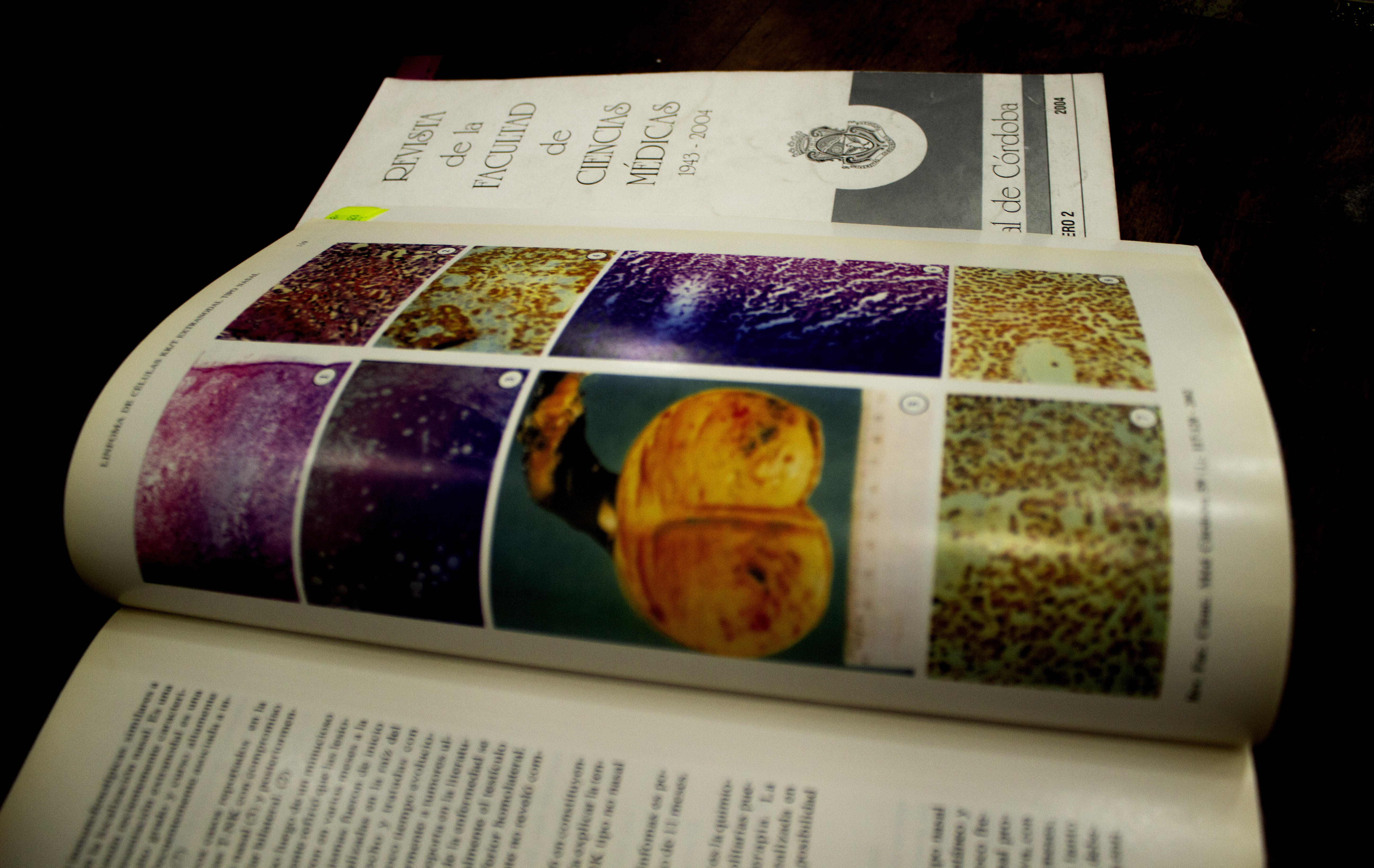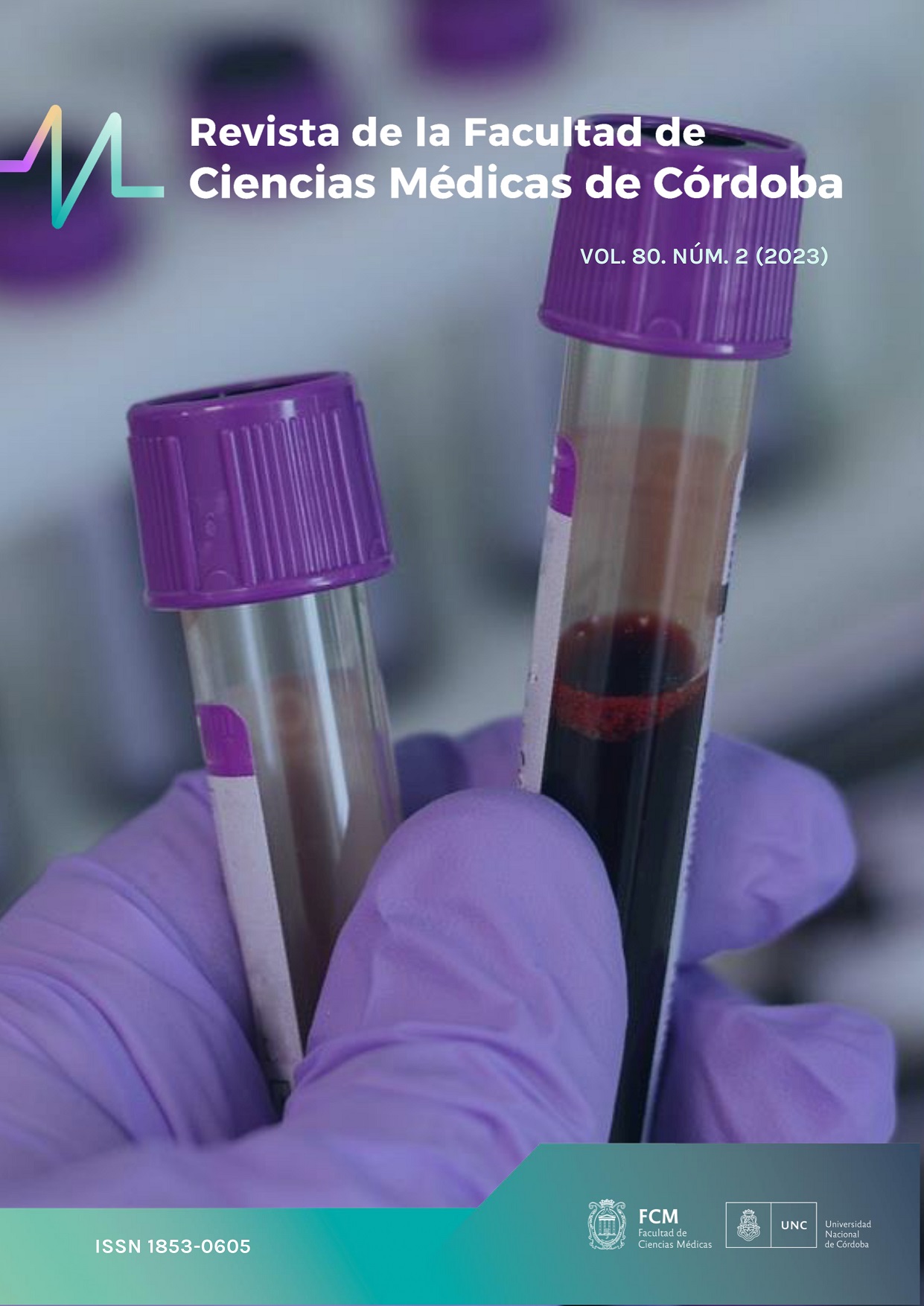Prevalence of noncommunicable diseases and risk factors in rural population of San Luis, Argentina
DOI:
https://doi.org/10.31053/1853.0605.v81.n1.42138Keywords:
rural health, epidemiology, ArgentinaAbstract
The objective of this study was to estimate the prevalence of diabetes mellitus (DM) and cardiovascular risk factors in a rural population in the province of San Luis, Argentina. Cross-sectional study developed between September and November 2017 with 18-year-old inhabitants and more than four towns in the Juan Martín de Pueyrredón department, San Luis. The participants answered questions by self-report on sociodemographic aspects, habits, psychosocial and risk factors for non-communicable diseases; physical measurements, FINDIRSC questionnaire and blood sample extraction were performed. Univariate estimates stratified by sex with their 95% confidence interval (95%CI) were obtained. We worked with sample expansion factors; crude and adjusted prevalences were calculated. The population consisted of 424 men (52.5%, 95%CI: 46.0-58.9) and 384 women (47.5%, 95%CI: 41.1-54.0). The adjusted prevalences for both sexes (by self-report) were: DM 11.8% (95%CI: 8.2-15.4); arterial hypertension (AHT): 35.5% (95% CI: 31.0-40.1); high cholesterol: 20.3% (CI 16.0-24.7). Males had significantly higher desirable HDL cholesterol and elevated blood pressure than females; women abdominal obesity in greater magnitude. 16.4% (95% CI: 11.0 - 23.6) had a high-very high risk of developing type 2 DM in the next 10 years. The adjusted prevalences of DM, hypertension, and high cholesterol were lower than those of the urban population of the province of San Luis. We highlight the pioneering contribution of this work to the knowledge of the health profile of rural communities in Argentina.
Downloads
References
1. World Health Organization. Noncommunicable Diseases Progress Monitor 2020. Genebra: World Health Organization; 2022. Disponible en: https://apps.who.int/iris/bitstream/handle/10665/353048/9789240047761-eng.pdf
2. Organización Panamericana de la Salud. La carga de las enfermedades no transmisibles en la Región de las Américas, 2000-2019. Washington D.C.: Organización Panamericana de la Salud; 2021. Disponible en: https://www.paho.org/es/temas/enfermedades-no-transmisibles
3. Secretaría de Gobierno de Salud de la Nación. Instituto Nacional de Estadística y Censo (Argentina). 4ta encuesta Nacional de Factores de Riesgo. Resultados definitivos. La secretaría, 2019. Disponible en: https://biblioteca.indec.gob.ar/bases/minde/enfr_2018_resultados_definitivos.pdf.
4. Franco CM, Lima JG, Giovanella L. Primary healthcare in rural areas: access, organization, and health workforce in an integrative literature review. Cad Saude Publica. 2021 Jul 7;37(7):e00310520. English. doi: 10.1590/0102-311X00310520.
5. Zapata ME, Rovirosa A, Carmuega E. Urbano y rural: diferencias en la alimentación de los hogares argentinos según nivel de ingreso y área de residencia. Salud Colect. 2019 Jul 29;15:e2201. doi: 10.18294/sc.2019.2201.
6. Salinas E, De Pauw MC, Sturniolo A, Aguirre MF, Marro MJ, Ballejo C, Lawrynowicz AEB. Estudio epidemiológico sobre enfermedades no transmisibles en población rural de San Luis, Argentina. Aspectos metodológicos. Rev Fac Cien Med Univ Nac Cordoba. 2021 Jun 28;78(2):118-124. doi: 10.31053/1853.0605.v78.n2.31304.
7. Lindström J, Tuomilehto J. The diabetes risk score: a practical tool to predict type 2 diabetes risk. Diabetes Care. 2003 Mar;26(3):725-31. doi: 10.2337/diacare.26.3.725.
8. Instituto Nacional de Estadísticas y Censos. Base de datos REDATAM. Cuestionario Básico. Disponible en: https://redatam.indec.gob.ar/argbin/RpWebEngine.exe/PortalAction?&MODE=MAIN&BASE=CPV2010B&MAIN=WebServerMain.inl&_ga=2.210626645.1366130706.1675863233-1261307949.1631734968
9. Rao, JNK, Scott, AJ. On Chi-squared Tests For Multiway Contigency Tables with Proportions Estimated From Survey Data. Annals of Statistics 1984; 12:46-60. doi: 10.1214/aos/1176346391.
10. Instituto Nacional de Estadísticas y Censos. Proyecciones nacionales. https://www.indec.gob.ar/indec/web/Nivel4-Tema-2-24-84.
11. The R Foundation. Core Team. R: A language and environment for statistical computing. R Foundation for Statistical Computing; 2022. Disponible en: https://www.R-project.org/.
12. Zhang J, Xiao S, Shi L, Xue Y, Zheng X, Dong F, Xue B, Zhang C. Differences in Health-Related Quality of Life and Its Associated Factors Among Older Adults in Urban and Rural Areas. Risk Manag Healthc Policy. 2022 Jul 27;15:1447-1457. doi: 10.2147/RMHP.S373077.
13. Tushi A, Rao SR, Pattabi K, Kaur P. Prevalence of risk factors for non-communicable diseases in a rural tribal population of Mokokchung, Nagaland, India. Natl Med J India. 2018 Jan-Feb;31(1):11-14. doi: 10.4103/0970-258X.243405.
14. Mota BG, Barp M, Guimarães RA, Rosso CFW, Rocha BS, Nunes CAB, Pagotto V. Prevalência de diabetes mellitus autorreferido e fatores associados em população rural e tradicional de Goiás: estudo transversal. Rev Bras Epidemiol. 2022 Jul 6;25:e220016. doi: 10.1590/1980-549720220016.2
15. Bezerra VM, Andrade AC, César CC, Caiaffa WT. Domínios de atividade física em comunidades quilombolas do sudoeste da Bahia, Brasil: estudo de base populacional. Cad Saude Publica. 2015 Jun;31(6):1213-24. Portuguese. doi: 10.1590/0102-311X00056414.
16. Yi JY, Kim H, Chi I. Urban-rural differences in multimorbidity and associated factors in China and Korea: A population-based survey study. Geriatr Gerontol Int. 2019 Nov;19(11):1157-1164. doi: 10.1111/ggi.13771.
17. Landmann Szwarcwald C, Nogueira Damacena G, Borges de Souza Júnior PR, Silva de Almeida W, Torquato Medrado de Lima L, Carvalho Malta D, Rizzato Stopa S, França Pontes Vieira ML, Azeredo Pereira C. Determinantes da autoavaliação de saúde no Brasil e a influência dos comportamentos saudáveis: resultados da Pesquisa Nacional de Saúde, 2013. Rev Bras Epidemiol, 2015. 18, (Suppl 2): 33-44. doi: 10.1590/1980-5497201500060004.
18. Jaime PC, Monteiro CA. Fruit and vegetable intake by Brazilian adults, 2003. Cad Saúde Pública 2005; 21(Suppl. 1): S19-S24. doi: 10.1590/S0102-311X2005000700003.
19. Grisa C, Schneider S. “Plantar pro gasto”: a importância do autoconsumo entre famílias de agricultores do Rio Grande do Sul. Rev Econ Sociol Rural 2008; 46(2): 481-515. doi: 10.1590/S0103-20032008000200008
20. Perestrelo JPP, Martins IS. Modernização rural: transformações econômicas e suas implicações demográficas, epidemiológicas e nutricionais nos municípios de Monteiro Lobato e Santo Antônio do Pinhal. Saúde Soc 2003; 12(2): 38-55. doi: 10.1590/S0104-12902003000200005.
21. Sposetti G, Fuentes N, Aguirre MF, Ballejo C, Marro MJ, Uez OC, López Miranda LA, Barragán A, Lawrynowicz A. Prevalencia de diabetes mellitus y factores de riesgo cardiovascular en adultos de Mar del Plata -BATÁN, 2015-2016. Rev Argent Salud Pública. 21 de diciembre de 2020;12:e26. Disponible en: https://rasp.msal.gov.ar/index.php/rasp/article/view/676
22. Azul AM, Almendra R, Quatorze M, Loureiro A, Reis F, Tavares R, Mota-Pinto A, Cunha A, Rama L, Malva JO, Santana P, Ramalho-Santos J; HeaLIQs4Cities consortium. Unhealthy lifestyles, environment, well-being and health capability in rural neighbourhoods: a community-based cross-sectional study. BMC Public Health. 2021 Sep 6;21(1):1628. doi: 10.1186/s12889-021-11661-4.
23. Piovani JI. Salvia A. Servicios de salud: cobertura, acceso y utilización. En: La Argentina del siglo XXI. Cómo somos, vivimos y convivimos en una sociedad desigual. Encuesta Nacional sobre la estructura social 2018. p. 265-290. Disponible en: https://d1wqtxts1xzle7.cloudfront.net/86666244/La_Argentina_en_el_siglo_XXI-libre.pdf?1653856491=&response-content-disposition=inline%3B+filename%3DLa_Argentina_en_el_siglo_XXI_como_somos.pdf&Expires=1708467409&Signature=S2ldledBl7nhgrnFg7xSEMVFaTu9gRXVxwPiX4g6ejbxmnZxzrrwLoo6QtkEVZUwGxQ7gKMkPJGmicXBCRo4PGUOSb3PieKC4DcfOS96MfHjtjqrdZNZPkgmNhRyygPpT6tFyy0lc27WZpSfPlA1R~7RVx0lmr5ljKtYKfxS6~ZXTWbf6vxQKitntWfC7pRye9O7KeNuYvnsdm2U1efDa7wReP54U43w6ypCBIg81h7~zLrVvAdYB7quk4K~VawK0KIcVlZSDxHF2J8FVW~VUsmTjXeoCTkQMJnRr3OG~XwMJMWGVTcrdOYRzUkVpsobEX-~IO6MyAXvHU3DduSIDA__&Key-Pair-Id=APKAJLOHF5GGSLRBV4ZA#page=265
24. International Diabetes Federation. Atlas de la diabetes de la FID, 9a ed. Bélgica: International Diabetes Federation; 2019. Disponible en: https://www.diabetesatlas.org/upload/resources/material/20200302_133352_2406-IDF-ATLAS-SPAN-BOOK.pdf
25. Tavares NU, Bertoldi AD, Mengue SS, Arrais PS, Luiza VL, Oliveira MA, Ramos LR, Farias MR, Pizzol TD. Factors associated with low adherence to medicine treatment for chronic diseases in Brazil. Rev Saude Publica. 2016 Dec;50(suppl 2):10s. doi: 10.1590/S1518-8787.2016050006150.
26. Pan L, Yang Z, Wu Y, Yin RX, Liao Y, Wang J, Gao B, Zhang L; China National Survey of Chronic Kidney Disease Working Group. The prevalence, awareness, treatment and control of dyslipidemia among adults in China. Atherosclerosis. 2016 May;248:2-9. doi: 10.1016/j.atherosclerosis.2016.02.006.
27. Sav A, King MA, Whitty JA, Kendall E, McMillan SS, Kelly F, Hunter B, Wheeler AJ. Burden of treatment for chronic illness: a concept analysis and review of the literature. Health Expect. 2015 Jun;18(3):312-24. doi: 10.1111/hex.12046.
28. Brito Nuñez JD, Cedeño Rondón J, Pérez Arciniega E, Brito Núñez N. Riesgo de diabetes mellitus según el cuestionario Finnish Diabetes Risk Score (FINDRISC) en Indígenas Warao de Barrancas del Orinoco, Monagas, Venezuela. Rev. salud pública [Internet]. 1 de julio de 2022 [citado 20 de febrero de 2024];24(4):1-5. Disponible en: https://revistas.unal.edu.co/index.php/revsaludpublica/article/view/75956.
29. Singh KN, Sendall MC, Crane P. Understanding Sociocultural Influences on Physical Activity in Relation to Overweight and Obesity in a Rural Indigenous Community of Fiji Islands. J Racial Ethn Health Disparities. 2023 Jun;10(3):1508-1517. doi: 10.1007/s40615-022-01336-0.
30. Ministerio de Economía. Secretaría de Política Económica. Dirección Nacional de Economía, Igualdad y Género. Las brechas de Género en Argentina. Estado de situación y desafíos, 2020. Disponible en: https://www.argentina.gob.ar/sites/default/files/las_brechas_de_genero_en_la_argentina_0.pdf.
Downloads
Published
Issue
Section
License
Copyright (c) 2024 Universidad Nacional de Córdoba

This work is licensed under a Creative Commons Attribution-NonCommercial 4.0 International License.
The generation of derivative works is allowed as long as it is not done for commercial purposes. The original work may not be used for commercial purposes.
















